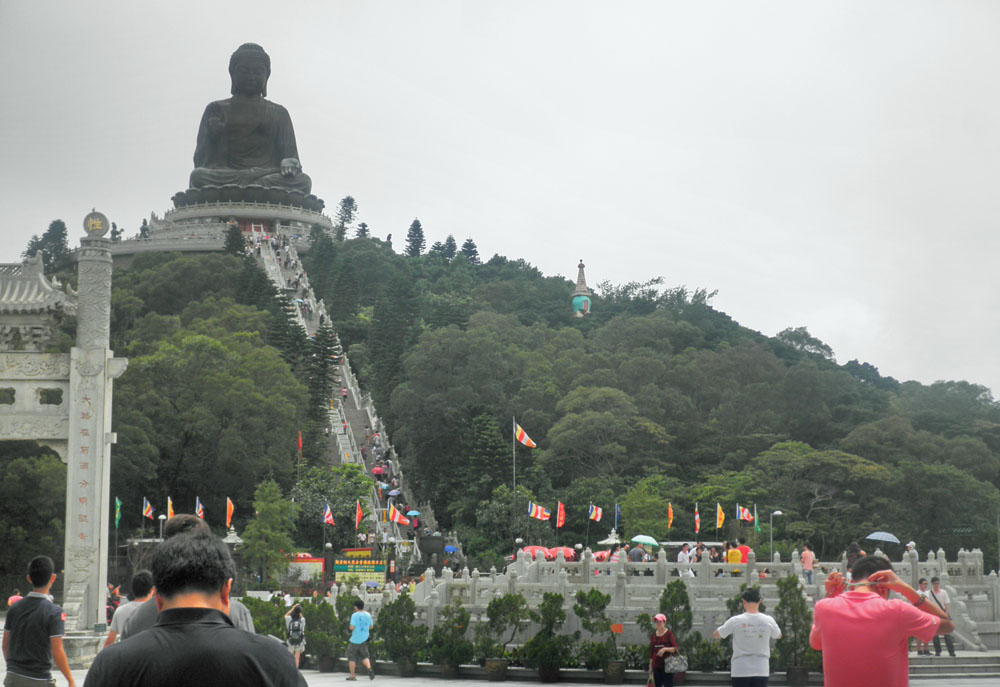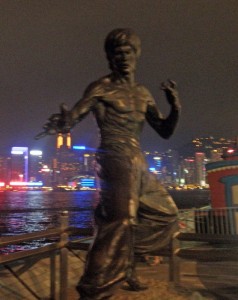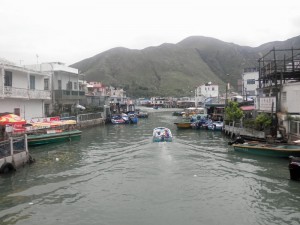Hong Kong: A model of free market success
By Guest
The Tian Tan Buddha symbolizes the peaceful relationship between man and nature from the highest peak as he keeps a watchful eye over the island.
Editor’s note: The following piece was submitted by Canton native Natalya Orlando about her recent trip to Hong Kong. Orlando’s roots go far back in the town — her great-great-grandfather was a Canton firefighter and her great uncle was a priest in Canton. She attended graduate school at the Brussels School of International Studies in Europe and was also a participant in Georgetown University’s free markets program this past July in Hong Kong. She’s currently campaigning for Ron Paul Across America.
As the plane descended, I saw the spectacular coastline and mountainous region that make Hong Kong a destination of such natural beauty. This was my first time in Asia and hoped it would be one of many. Fifteen hours later, I was finally on the other side of the world.
From the moment I landed there, it was nothing short of amazing. As a special administrative region of the People’s Republic of China, Hong Kong follows the “one country, two systems” model, referring to how its political system differs from the mainland. As a sovereign state, Hong Kong enjoys a high level of autonomy for the next 100 years as stipulated by the British government upon passing control back to China in 1997.
The first weekend I was there, I toured Hong Kong and saw the famous city skyline of Kowloon. I walked along the Avenue of Stars under the beautiful night sky illuminated by the bright lights along the water. Modeled after Hollywood’s Walk of Fame, Kowloon pays tribute to some of Hong Kong’s most famous residents, such as the late Bruce Lee, Jet Li and Chow Yun-Fat.
Halfway along the Avenue of Stars, Bruce Lee, Hong Kong’s most famous resident, is memorialized in bronze against the backdrop of the skyline. Serving as a sad reminder of his premature death, the statue depicts him striking his classic pose as seen in his 1972 movie The Fist of Fury.
World renowned for its economic prosperity and high quality of life, Hong Kong is the world’s freest economy according to the Index of Economic Freedom. Jointly created by the Wall Street Journal and the Heritage Foundation, the index measures the degree of economic freedom in every country around the globe.
Implementing Adam Smith’s belief that individual liberty results in greater prosperity for all of society, the index designates which nations are more conducive to economic prosperity. As a supporter of free markets and limited government, I witnessed Hong Kong’s economy firsthand in a program through Georgetown University.
In conjunction with the Asia Institute for Political Economy, I spent the month of July studying economics and Hong Kong’s free market economy. Our professors covered various topics, including the theories of classical economists Friedrich Hayek and John Maynard Keynes, equality vs. inequality, taxes, economic prosperity and free trade.
In contrast to government intervention, we focused specifically on why a non-intervention public policy will result in a prosperous and vibrant economy. Another component of this unique program was to hear from the leading political, business and economic experts in Hong Kong today. Memorable guest speakers included Richard Vuylsteke, president of the American Chamber of Commerce in Hong Kong; Thomas Easton, Asia business editor of The Economist; and Andrew Work, co-founder of the Lion Rock Institute, Hong Kong’s leading free market think tank.
While there, I wanted to absorb the culture and interact with the residents, which I was able to do during our first out-of-class activity. An exciting yet challenging assignment for our economics class was to negotiate for five items at the night market. Temple Street marks the location of Hong Kong’s longtime tradition of vendors lining the streets selling their goods at rock-bottom prices. The night market was bright, humid and crowded as I witnessed shoppers haggling with merchants in Mandarin.
I spent a lot of time just wanting to get lost in Hong Kong and immerse myself into its customs and traditions. A lot of us spent time exploring Lan Kwai Fong, which is a section of cobblestone streets lined with numerous shops, restaurants, bars and clubs. Known for its nightlife, Lan Kwai Fong is home to the unique Balalaika Russian Ice Bar & Restaurant. Well known for its closed-in freezer ice bar, it can accommodate a small party and is stocked with a full bar, ice counters, ice seats and fur mats.
While there, I wanted to see other parts of Asia, which prompted a weekend visit to China’s other administrative region, Macau, as well as Lantau Island. I also toured an old Chinese fishing village, sang karaoke, visited an interactive exhibit in the dark, went to a trolley party, ate dim sum, climbed the highest peak for a stunning view of Hong Kong, and got caught in a typhoon.
Hong Kong was not the only destination to choose from, but I clearly picked the right one. Due to China’s oppressive government and communist policies, I have had some people ask, “Why China?” Anyone who has been there would understand.
Hong Kong felt like paradise with its tropical climate and stunning landscape. It is an enchanting place full of history, high-rise buildings, mountains, bays, parks, waterfalls, and sections reminiscent of a jungle. It is, after all, Asia’s Gateway City, known for its skylines, the ice bar and free markets.
Short URL: https://www.thecantoncitizen.com/?p=10497












